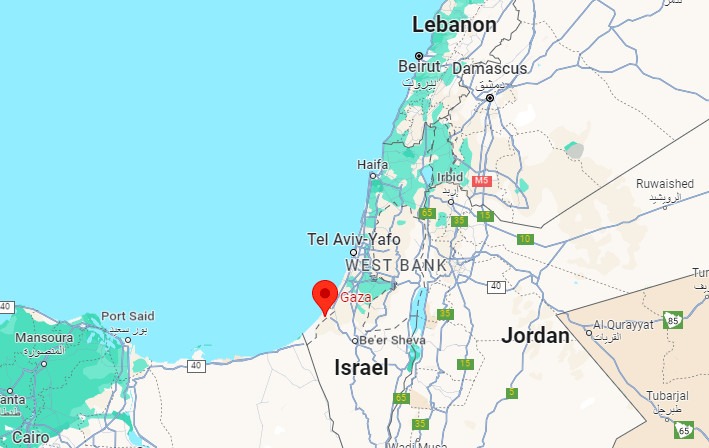
Fifty years after two neighbouring Arab states, Egypt and Syria, attacked Israel during what was called the “Yom Kippur War” (6-26 October 1973), the terrorist organisation Hamas launched a sea, land and air attack on several towns. Hundreds of civilians were killed, dozens more were kidnapped and forcibly transported to Gaza and the Israeli public at large is shocked by the scale of the attack and the fragility of the border security walls.
Israel has been politically deadlocked for months in the midst of a judicial reform promoted by Benjamin Netanyahu’s government and challenged in the streets by the opposition on a weekly basis since the beginning of 2023.
Military and security service leaders have also been embroiled in the dispute. Palestinians, for their part, are divided between the administration of the Fatah Movement, led by Mahmoud Abbas, the president of the National Authority, and the Hamas movement, which controls Gaza.
On top of these differences have come the real prospect of the establishment of diplomatic relations between Israel and Saudi Arabia, an event that would isolate Iran and paramilitary and terrorist groups in the Middle East and the Arab world.
But what is the Gaza Strip?
When the last of the nearly 1,000 Israeli soldiers left the Gaza Strip for good in 2005 in the Knesset (parliament) in Jerusalem, voices such as Isaac Herzog’s announced that a period of prosperity would finally come for the Palestinian territory that would bring it to the economic and financial profile of the former British colony Hong Kong. Gaza has all the geographical prerequisites to become one of the most important poles of world economic relations. The territory borders the Mediterranean Sea, lies between Egypt and Israel, a very short distance from the Suez Canal, at the crossroads of the most important routes through the Middle East.
Fifteen years after the Israeli withdrawal, Gaza produces nothing and exports only terrorism. There is no port or airport on its territory and no motorway or railway runs through the land. In addition, almost 50% of Gaza’s Gross Domestic Product is made exclusively from the wages and income of those working in Israel. And since 2007 the territory has been politically occupied by the Islamist Hamas, which is in conflict with Fatah, the Palestinian ruling party in Ramallah, in the West Bank.
Gaza is an area of 360 square kilometres, with a population of more than 2.5 million (all Arab and Muslim), 41 kilometres long and varying in width from 6 to 12 kilometres.
The Gaza Strip’s border with Egypt is 11 kilometres long, with the State of Israel it is 51 kilometres long and the Mediterranean coastline stretches 40 kilometres. The two borders are hermetically sealed and demarcated by high fences, with neither Egypt nor Israel allowing the free movement of people and goods. The Gaza Strip’s skilled labour force is employed in unskilled jobs in Israel (mainly in construction, infrastructure and the hospitality industry) and another part is engaged in citrus growing, the Strip’s other economic branch. Egypt does not allow Gazans to work in Gaza, but there is little pressure to do so since wages in Israel are also 10 times higher than in neighbouring countries.
However, most Gazans – around 40% of those able to work – are unemployed. The percentage is as high as 90% among young people under 30. Most families live on the edge of subsistence, on stipends and food and medical aid provided by humanitarian organisations, UN agencies and various European and US states. Population density and lack of economic and personal prospects have created an explosive territorial reality, with most inhabitants not being welcomed in either Israel or Egypt and therefore unable to leave the 360 square kilometre perimeter.
The Gaza Strip has no airport or port, no highway or railway (the existing one was built during the British Mandate over Palestine after the First World War, but is no longer operational). There is no industry in Gaza, just as there are no tertiary economic sectors (hospitality, services, IT, banking). The territory’s trade with the outside world is extremely low, the only notable export being oranges. As a result, revenues do not cover the costs of public services, education and health. Frequent Israeli raids following grenade, drone or rocket attacks from Gaza have repeatedly destroyed residential buildings in Gaza City (where the residences of Hamas leaders are located) but have also affected the poor communications infrastructure in the Strip, such as electricity, mobile telephony and natural gas supplies.
How did Gaza emerge?
After the UN divided British-held Palestine between Arabs and Jews in 1947, the state of Israel proclaimed its independence in May 1948. Within hours of Israel’s declaration of independence, neighbouring Arab countries declared war. The military conflict was won by Israel and part of the territories agreed to be the Palestinian state were occupied.
As a Palestinian state never emerged, in 1948 Gaza City was occupied by Egypt and became an Egyptian administrative region. Arabs from Israel and other neighbouring states, who had owned property in Palestine until 1948, began arriving here. Egypt neither intended nor had the resources to develop Gaza and especially its coastline. On the contrary, for two decades Gaza became a mere refugee camp, politically, religiously and diplomatically instrumentalised in the conflict with Israel.
During the Six-Day War in June 1967, Israel took over the whole of Jerusalem, proclaiming it the capital of the state, but also annexed Palestinian territories held by its neighbours. These include Gaza (from Egypt) and the West Bank (from the Hashemite Kingdom of Jordan), two of the states that triggered the 1967 conflict.
Gaza became a territory administered both civilly and militarily by Israel until 2004-2005. Agricultural farms adapted to the desert region, small industrial and commercial enterprises were set up here, and Jewish settlements numbering almost 10,000 souls were established. Israel has invested in irrigation, water supply, electricity and gas distribution. The huge demographic disparity in Gaza (2 million Arabs to 10,000 Jews), international pressure to settle the issue of a Palestinian state and radical Islamist excesses in the territory persuaded Israel’s prime minister, Ariel Sharon, to decide to withdraw. In 1988, the radical Islamist group Hamas emerged, which also coordinated the four-year uprising (1987-91) in the Israeli-held Palestinian territories known as the Intifada.
The 1993 Oslo Accords signed between Israel (through Prime Minister Yitzhak Rabin) and the Palestinians (through Yasser Arafat, leader of the Palestine Liberation Organisation) defined the relationship between the two sides and the internal autonomy of the Palestinian National Authority. The latter comprises two territories: the West Bank, where Ramallah, the administrative centre, is located, and the Gaza Strip.
The last parliamentary elections in the Palestinian National Authority were held in 2006. At that time, Hamas won against the other party, Fatah, led by Palestinian Authority President Mahmoud Abbas.
Since 2007, Hamas has taken full control of Gaza after Fatah and Mahmoud Abbas refused to cooperate and dissolved the government.
Basically, since 2007, the Palestinian National Authority has been divided into two separate entities that do not cooperate with each other: The West Bank, led by President Mahmoud Abbas (86), and Gaza, occupied by the Islamist Hamas movement.
Gaza and Israel: Forever war
Since 2007, rockets and terrorist commandos have been regularly sent from the Gaza Strip to Israel. On several occasions, the Israeli army has bombed Gaza City and the underground tunnels on the border. The leaders of Hamas, an organisation recognised as terrorist by the vast majority of the international community, deny the right of the State of Israel to exist and call on Arab states to break off all relations with the Jerusalem authorities.
In recent years, however, and particularly during Donald Trump’s Republican administration in Washington, the future of a Palestinian state has looked increasingly fragile. After Jordan and Egypt, other Arab states such as the United Arab Emirates, Bahrain, Sudan and Morocco have established diplomatic relations with Israel. Others, such as Oman, Saudi Arabia and Iraq, have increasingly close ties. In these Arab capitals, the issue of the Palestinians is increasingly irrelevant in the face of Israel’s economic, financial, military and diplomatic importance. The Gaza Strip, like the Palestinian National Authority as a whole, has become a secondary issue in the Middle East, as evidenced by the dwindling financial aid coming from Arab states.
The recent conflict between Israel and the Gaza Strip, which has been more intense than others, also has some ingredients that were missing from previous clashes.
First, the coronavirus pandemic, which has closed Israel’s borders for more than a year, including to most foreign workers. Travel between Gaza and Israel has been difficult for them, when it hasn’t been stopped altogether. The economic sectors in which Palestinian Arabs from Gaza are employed in Israel have also suffered most (construction, tourism, trade). As a result, incomes in the Gaza Strip have fallen dramatically, if not disappeared altogether.
Secondly, the long-serving president of the Palestinian National Authority, Mahmoud Abbas, has again cancelled parliamentary elections, which provoked a reaction from Hamas (which was expecting victory in Gaza) and led to violent reactions against rival Fatah, accused of collaborating with Israel. As the Israeli parliamentary elections did not produce a government in Jerusalem either, there was also voter fatigue in Israel, fatigue of the public opinion (after a year of pandemic restrictions) and settlement plans (most of the West Bank is to become Israeli administrative territory).
Thirdly, like Russian President Vladimir Putin, the Hamas movement in the Gaza Strip was also keen to test the policy of the new administration in Washington, led by Joe Biden, particularly on the desirability of supporting a Palestinian state and, of course, the strength of the alliance with Israel.
Even if it brings loss of life and material destruction, the current conflict between Israel and the Gaza Strip will not solve the underlying problem. For it will bring neither peace, nor the defeat of the State of Israel, nor victory for the Palestinians in Gaza.
Ne bucurăm că ne citești!
Dacă vrei să ne și susții:










